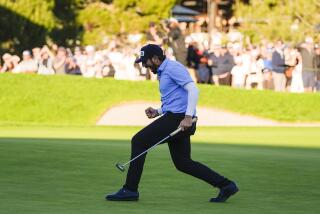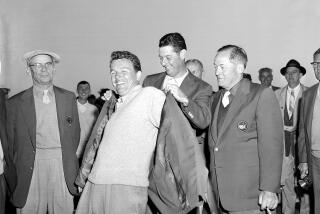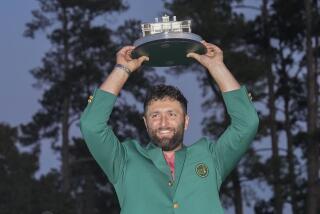He Fits Right In With Other Legends of Golf
- Share via
Raymond Floyd may be the last of the golf superstars. If he isn’t, Tom Watson is.
A superstar, by definition, must be a man who: 1) has won more than 20 tournaments; 2) has won two or more majors; 3) has maintained top form over decades of tournament play; 4) is a “one to beat” in every tournament he enters.
A superstar has to be identifiable by one name only. Around a locker room when you say “Arnold,” it is all you have to say. When you say “Jack,” it can mean only one person. And when you say “Raymond,” no one says “Raymond Who?”
Raymond grew up in a colorful era of the game when you had to chip and putt for everything you got. No one paid you thousands to wear their clothing logo or caps with golf balls or car names on them. You couldn’t be a leading money-winner without winning a tournament, and you had to augment your income by side trips into hustler golf to make ends meet.
Raymond won a tournament and finished in the money several times in 1963, his first year on the tour--and grossed $10,529. He got $3,500 for the victory, which came at St. Petersburg, Fla.
To show you what’s happened to golf, Raymond won at Doral in 1980--and got $40,000. He won at Doral in 1981--and got $45,000. He won at Doral this year--and got $240,000.
When Raymond joined the tour fairways, Hogan was still abroad on them. Snead was still a factor. Nicklaus was young. Arnold and his Army were in full cry.
With this crowd, you had to learn shots--or go back to cleaning clubs for a living. The game was not a drive-and-an-eight-iron-and-one-putt.
You also had to take the game out behind the barn, so to speak. Not exactly put on glasses and fake whiskers, but you didn’t want the USGA to find out about you. Some of Raymond’s most desperate matches were not for Bob Hope’s or Chrysler’s or Nabisco’s money. It was for Raymond’s.
The legendary gambler, Titanic Thompson, came up to him once and persuaded Raymond to come down to El Paso to take on a young Mexican with a putting stroke you could set to music, nonstop chatter and the guts of a train robber. “There are guys who will bet a lot of money on him,” Titanic Thompson told Raymond. “I’ll play anybody I never heard of,” Raymond promised Titanic.
Three days later, he had heard of Lee Trevino, all right. Three years later, the whole world had. Lee was to win two U.S. Opens, PGAs and British Opens.
But he was just one of Ti Thompson’s scams at the time. “I’ll never forget our match,” Floyd says. “The first day, I shot 65. And he waxed me by two. The next day, I shot 64 and he waxed me by one. The third day, we doubled the bets. I had an 18-footer for a 63 on the 18th. Lee had a 15-footer. I made mine. Then his went down in the cup and came out again. I can still see that putt in my sleep. How it stayed out of the hole, I don’t know. If it hadn’t, he would have shot 63-63-63. I used the only Spanish I would ever know. ‘Adios, amigo,’ I told Lee.”
Those kinds of things fitted a man for the tour--as Trevino himself would shortly find out.
Raymond went on to win a U.S. Open, two PGAs, a Masters and 20 other tournaments. He finished second in a British Open, or he would have joined the list of only three players who have won all four majors--Nicklaus, Hogan and Gary Player.
Raymond became the tour’s resident zombie. Whenever his eyes glazed over, his face became a mask of concentration and he seemed to be looking down a fairway at something no one else could see, the field knew it was all over.
When Raymond got in a catatonic state, he was Frankenstein with a nine-iron. “My wife, Maria, says she’s seen me win without that look--but she’s never seen me lose with it,” Floyd says.
There is a scene in the movie “Sunset Boulevard” where the aging star, Gloria Swanson, looks away from the silent screen and says: “We had faces in those days!” In a way, the golfers of the past can make the same statement. Today’s tour is often a gallery of faceless backspin artists. No one rises from the crowd. A star doesn’t win week after week. An extra does.
It is what has made the PGA Senior Tour the phenomenon of close-of-the-century sports world. It is the only golf tour that offers a field of recognizable silhouettes. Golf is a game that can be played better at 40 than it can at 20 because so much of it is cerebral. And it can be played almost as well at 50 as at 40.
Raymond Floyd, at 50, has one foot in each tour, the only man to win a senior event and regular event in the same year. Raymond became the second oldest player to win a tour event in history. He was 49 when he won this year’s Doral. Sam Snead was 52 when he won in 1965. Raymond won a senior tournament at Indianapolis three weeks ago.
Raymond Floyd’s familiar figure will be one of the dream team cast of characters who will tee it up in the Ralph’s Senior Classic, sponsored by the grocery chain, at Rancho Park next week. Palmer and Player will also be on hand.
Raymond Floyd will get more for finishing high in this company than he did for, say, finishing ahead of Hogan in the 1965 Masters--or winning the ’76 Masters, for all of that.
And, if he shows up with the look in his eye of an extra-terrestrial who just got out of a spaceship, the rest of the field had better call in the National Guard.
More to Read
Go beyond the scoreboard
Get the latest on L.A.'s teams in the daily Sports Report newsletter.
You may occasionally receive promotional content from the Los Angeles Times.










